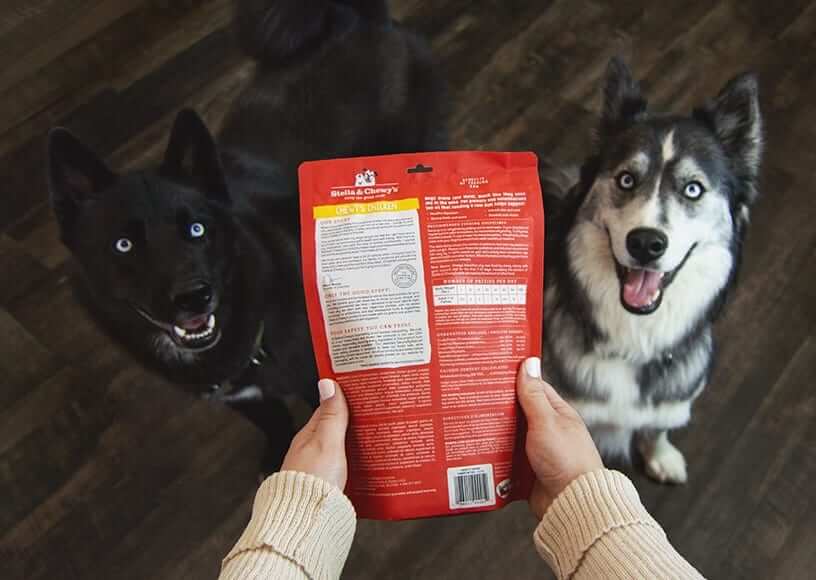
Written by Veterinarian Dr. Greg Martinez
What information can you get from reading the nutrition label on the side or back of a package, box, or can of dog food? The label on a package of dog food lets us know the types and amounts of ingredients used in our pet’s food. High-quality pet foods, like Stella and Chewy’s, have named animal meat and organ meat, as well as organic vegetables and fruits as main ingredients. Since the ideal dog food is a natural mixture of meat, organs and smaller amounts of carbohydrates, you can easily spot those quality ingredients in the best foods. In some cheaper dog food, the animal proteins are not identified. The label may list them as animal fat, or animal digest, instead of chicken, beef, lamb, or turkey. With these terms, you really don’t know what you’re getting.
When reading dog food labels, the first five ingredients are the most important, as they represent what makes up the bulk of the food. When the ingredients listed are animal proteins, followed by fruits or vegetables, you’re on the right track. Too many by-products may signal a lack of quality meat or too many processed carbohydrates. Meat by-products may not be the kind of protein your pet needs without adding any valuable nutrition to the mix. Examples of top-quality ingredients you would find on the label are grass-fed beef, wild-caught salmon, cage-free chicken, and organic produce. Examples of poor-quality ingredients are chicken by-products, wheat gluten, corn, and animal digest.
Raw food is a more natural mix of meat, organs, and veggies that mirrors nature’s formula of protein and fat, found in the prey animal that fed the ancestors of our fur friends. Raw and less processed foods do not require the long list of artificial flavors, dyes, and preservatives needed in low quality foods. Artificial dyes are used to visually entice humans – our dogs don’t even see the range of colors that we do! There is no need to include any ingredients that do not add any nutritional value to the food.
The percentages of protein and fat on the dog food nutrition label give us an idea of the amount of meat or carbohydrate that the recipe contains.. More moist dog foods often show much lower percentages. For example, 60% protein in a dry food may drop to 15% in a moist food, but the nutrition is exactly the same and water dilutes the protein and fat. In fact, more water in the recipe helps with digestion and kidney function.
To get an idea of how ingredients differ, compare the first 12 ingredients from two real dog food labels:
1. Chicken with ground bone, chicken liver, chicken gizzard, pumpkin seed, organic cranberries, organic spinach, organic broccoli, organic beets, organic carrots, organic squash, organic blueberries, fenugreek seed
2. Chicken, poultry by-product meal (source of glucosamine), brewers rice, whole grain corn, whole grain wheat, corn gluten meal, corn germ meal, medium-chain triglyceride vegetable oil, barley, fish meal (source of glucosamine), dried egg product
Which list of ingredients would you pick for your pet? The choice is obvious: #1 has much better ingredients. Those ingredients are what you’ll find in Stella and Chewy’s – Chewy’s Chicken Freeze-Dried Raw Dinner Patties. It’s always a good idea to talk to your vet before making any drastic changes to your dog’s diet, to address any concerns about their unique nutritional needs.
*Dr. Greg Martinez, DVM, was paid for his time but all opinions remain his own.
About The Author
Greg Martinez, DVM has been a partner/owner of Gilroy Veterinary Hospital in Gilroy, California for more than 30 years. He is the author of three books: Dr. Greg’s Dog Dish Diet, Dog Diet Answer Book, and Feed Your Pet to Avoid the Vet. You can learn more about Dr. Greg by visiting his YouTube channel.
Learn more tips for reading pet food labels, including calorie content and feeding guidelines!
GET $3 OFF, INSIDER OFFERS, AND HELPFUL PET CARE TIPS.
By entering your information, you are opting in to receive communication from Stella & Chewy's
